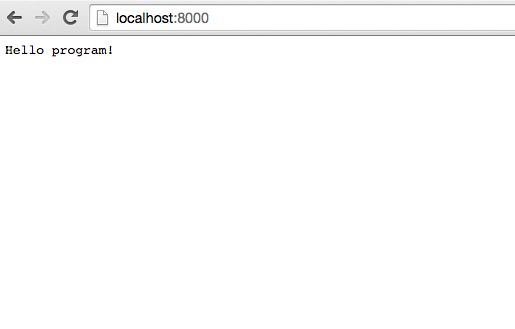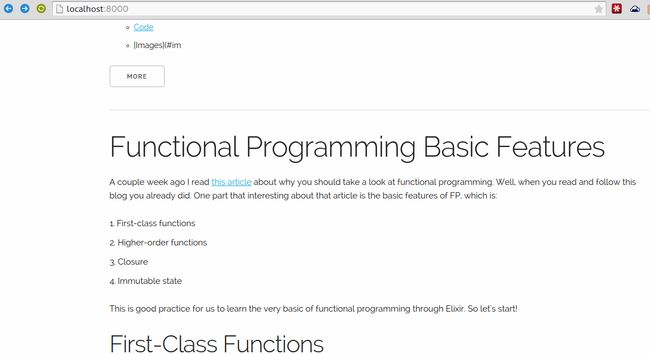前言:学习Elixir的时候,发现了一篇文章,使用Cowboy框架做一个简单的blog。看完之后受益匪浅,随翻译,重新阅读一遍,英文比较渣,多数词不达意。原文有两个小错误,已经修改。其次就是原文使用的
markdwon库,现在已经不可用了。为此更换了另外一个库earmark。Elixir作为函数式语言,递归能力很强大,文中例子在处理首页的时候,尤其体现了它的魔力。
使用cowboy和tornado做了一次并发测试,cowboy的性能比tornado快大概4-5倍。
Cowboy 教程 2:创建一个基于文件的扁平化博客
如果你一直阅读ElixirDose的博文,那么肯定知道之前我们已经创建了一个十分简单的框架(web framework)。本篇文章,我们将会介绍一个响应markdown文件的服务器例子。我们的markdwon服务器要比之前的博客程序更深入一点。上一篇文章确实有点过时,因此我们一起从头开始学习cowboy, 一个小巧,快速,可扩展的Erlang写的HTTP服务器。
对于将要实现的博客程序,让先讨论更多关于它的细节吧。预期的博客程序可以从文件夹中读取markdown文件。任何没有数据库渠道的博客都很快很酷炫。写文章的时候,只需要用编辑器写markdown文件接口,然后放入到文件夹中,随后就能发布文章了,快速且简单。我们还得支持更换主题,以便未来有一天可以重新设计博客。
创建一个博客程序,首先需要知道下面的topics:
- 使用Cowboy处理静态文件(图片,css样式表,javascript)
- 将markdown文件转换成html文件
- 根据浏览器url动态的匹配markdown博客文件
- 渲染
EEx模板,字符串操作,修改主题样式。
实现本教程的项目,开发环境如下:
- Elixir 1.0.0 或更高版本
- Cowboy 1.0.1 版本,
- 使用 ExDoc 作为 markdown工具
开始吧!
创建 Elixir 项目
使用mix工具开启elixir项目之旅。
$> mix new dds_blog --sup
博客程序名dds_blog, 其为Drop Dead Simple Blogging的缩写。--sup参数表示让mix创建一个OTP supervisor 程序和在 DdsBlog模块中创建OTP应用回调函数。
别忘了进入刚才新建的dds_blog文件夹:
$> cd dds_blog
好了,是时候召唤cowboy出场啦。
添加 Cowboy
为了实现我们的博客,需要一个后端服务器处理http请求。Cowboy非常合适,并且足够awesome。
打开mix.exs文件,添加Cowboy为项目的依赖。
defp deps do
{:cowboy, "1.0.0"}
end
然后在mix.exs文件中的application中指定:cowboy:
def application do
[applications: [:logger, :cowboy],
mod: {DdsBlog, []}]
end
运行 mix deps.get 获取安装依赖
$ mix deps.get
Running dependency resolution
Unlocked: cowboy
Dependency resolution completed successfully
ranch: v1.0.0
cowlib: v1.0.1
cowboy: v1.0.0
[..]
如您所见,除了Cowboy,我们还下载了cowboy本身的依赖cowlib 和 ranch。
创建 Cowboy 路由
创建一个函数用于定义项目的路由规则:
def run do
routes = [
{"/", DdsBlog.Handler, []}
]
dispatch = :cowboy_router.compile([{:_, routes}])
opts = [port: 8000]
env = [dispatch: dispatch]
{:ok, _pid} = :cowboy.start_http(:http, 100, opts, [env: env])
end
项目应用启动的时候,可以自动用run函数。这个设置也是可选的,如果不这样,你就得手动调用一遍启动程序。其他的代码大概如下:
defmodule DdsBlog do
use Application
def start(_type, _args) do
import Supervisor.Spec, warn: false
children = [
worker(__MODULE__, [], function: :run)
]
opts = [strategy: :one_for_one, name: DdsBlog.Supervisor]
Supervisor.start_link(children, opts)
end
def run do
routes = [
{"/", DdsBlog.Handler, []}
]
dispatch = :cowboy_router.compile([{:_, routes}])
opts = [port: 8000]
env = [dispatch: dispatch]
{:ok, _pid} = :cowboy.start_http(:http, 100, opts, [env: env])
end
end
如果启动程序,访问http://localhost:8000/就能看的响应结果啦。
处理请求
上面的代码可知,路由"/"绑定了处理模块DdsBlog.Handler。接下来可以在模块写代码,用于响应请求。创建一个lib/dds_blog/handler.ex文件,并添加下面的代码:
defmodule DdsBlog.Handler do
def init({:tcp, :http}, req, opts) do
headers = [{"content-type", "text/plain"}]
body = "Hello program!"
{:ok, resp} = :cowboy_req.reply(200, headers, body, req)
{:ok, resp, opts}
end
def handle(req, state) do
{:ok, req, state}
end
def terminate(_reason, _req, _state) do
:ok
end
end
init函数做了很多工作。首先它告诉cowboy是什么类型的连接,我们将要处理基于TCP的HTTP。然后使用:cowboy_req.reply 函数设置了200状态码和http的headers列表,body内容和请求本身。
目前暂且不用处理handle 和 terminate函数,把他们当成样板来对待吧。
首次运行
现在开始第一次运行应用程序:
$> iex -S mix
Erlang/OTP 17 [erts-6.2] [source] [64-bit] [smp:4:4] [async-threads:10] [hipe] [kernel-poll:false] [dtrace]
==> ranch (compile)
Compiled src/ranch_transport.erl
Compiled src/ranch_sup.erl
Compiled src/ranch_tcp.erl
Compiled src/ranch_ssl.erl
Compiled src/ranch_protocol.erl
Compiled src/ranch_listener_sup.erl
Compiled src/ranch_app.erl
Compiled src/ranch_acceptors_sup.erl
Compiled src/ranch_acceptor.erl
Compiled src/ranch.erl
Compiled src/ranch_server.erl
Compiled src/ranch_conns_sup.erl
==> cowlib (compile)
Compiled src/cow_qs.erl
Compiled src/cow_spdy.erl
Compiled src/cow_multipart.erl
Compiled src/cow_http_te.erl
Compiled src/cow_http_hd.erl
Compiled src/cow_date.erl
Compiled src/cow_http.erl
Compiled src/cow_cookie.erl
Compiled src/cow_mimetypes.erl
==> cowboy (compile)
Compiled src/cowboy_sub_protocol.erl
Compiled src/cowboy_middleware.erl
Compiled src/cowboy_websocket_handler.erl
Compiled src/cowboy_sup.erl
Compiled src/cowboy_static.erl
Compiled src/cowboy_spdy.erl
Compiled src/cowboy_router.erl
Compiled src/cowboy_websocket.erl
Compiled src/cowboy_protocol.erl
Compiled src/cowboy_loop_handler.erl
Compiled src/cowboy_http_handler.erl
Compiled src/cowboy_rest.erl
Compiled src/cowboy_handler.erl
Compiled src/cowboy_clock.erl
Compiled src/cowboy_bstr.erl
Compiled src/cowboy_app.erl
Compiled src/cowboy_http.erl
Compiled src/cowboy.erl
Compiled src/cowboy_req.erl
Compiled lib/dds_blog/handler.ex
Compiled lib/dds_blog.ex
Generated dds_blog.app
Interactive Elixir (1.0.1) - press Ctrl+C to exit (type h() ENTER for help)
iex(1)>
如果没有把run函数作为supervisor 树中的worker的子函数,那么就得在命令行运行项目。除此之外,一切顺利,打开浏览器访问http://localhost:8000/将会看到,全世界最美妙的编程单词 :)
静态文件处理
给Cowboy增加静态文件处理功能:图片,css样式表,js脚本等。每当请求http://localhost:8000/static/的时候,cowboy将会从接下来将要创建的静态文件夹中提取文件响应。现在,先打开lib/dds_blog.ex 增加一个路由吧:
def run do
routes = [
{"/:something", DdsBlog.Handler, []},
{"/static/[...]", :cowboy_static, {:priv_dir, :dds_blog, "static_files"}}
]
dispatch = :cowboy_router.compile([{:_, routes}])
opts = [port: 8000]
env = [dispatch: dispatch]
{:ok, _pid} = :cowboy.start_http(:http, 100, opts, [env: env])
end
别忘了新建priv/static_files文件夹用于存放静态文件
$> mkdir -p priv/static_files
在static_files文件夹中放一些文件,然后运行iex -S mix启动程序,浏览器访问,将会看到响应图片啦:
很简单,对不对?
处理 markdown文件
有趣的才刚刚开始。思路是:访问http://localhost:8000/some-markdown-file,程序会寻找 priv/contents/ 文件夹内名为some-markdown-file.md 的文件,然后将该文件的内容转成html格式,最后再把html内容响应给浏览器。
修改路由内容:
def run do
routes = [
{"/:filename", DdsBlog.Handler, []},
{"/static/[...]", :cowboy_static, {:priv_dir, :dds_blog, "static_files"}}
]
dispatch = :cowboy_router.compile([{:_, routes}])
opts = [port: 8000]
env = [dispatch: dispatch]
{:ok, _pid} = :cowboy.start_http(:http, 100, opts, [env: env])
end
目前的路由设置将会接受任何url。然后修改dds_blog/handler.ex中的处理函数,在Cowboy中,url写可以和字符串绑定(binding)。最开始我以为是查询字符串(query strings),可是我错了。查询字符串的写法是这样的 http://localhost:8000/?query=yes。可是我们想要的写法是这样的http://localhost:8000/some-file。因此我们使用url绑定.
打开lib/dds_blog/handler.ex ,通过请求的url,可以知道响应哪一个文件。
def init({:tcp, :http}, req, opts) do
{:ok, req, opts}
end
def handle(req, state) do
{method, req} = :cowboy_req.method(req)
{param, req} = :cowboy_req.binding(:filename, req)
IO.inspect param
{:ok, req} = get_file(method, param, req)
{:ok, req, state}
end
def get_file("GET", :undefined, req) do
headers = [{"content-type", "text/plain"}]
body = "Ooops. Article not exists!"
{:ok, resp} = :cowboy_req.reply(200, headers, body, req)
end
def get_file("GET", param, req) do
headers = [{"content-type", "text/html"}]
{:ok, file} = File.read "priv/contents/filename.md"
body = file
{:ok, resp} = :cowboy_req.reply(200, headers, body, req)
end
在priv/contenst文件夹中放一些markdown文件。如果文件夹不存在,就创建一个啦。首先使用:cowboy.bindings从url获取文件名,然后把其当成参数传入get_file函数中。get_file函数有两个类型签名,一个函数有参数,另外一个函数没有参数(使用:undefined作为参数)。如果无法从url获取文件名参数,则其值为 :undefined。正常用于响应文件找不到的请求,否则这回使用文件名参数调用get_file。
当接受参数之后,读取priv/contents文件夹的文件。此时,设置的文件是filename.md。我们将会看到如下的输出(纯markdown)
响应的内容是markdown的原始内容。因此我们需要将markdown转会成html,我们需要一个库/包来帮我们转换。增加earmark包到mix.exs文件。(译者注:原文使用的库是 markdown,实际试验,最新版的markdown也无法编译,使用earmark代替了)
defp deps do
[
{:cowboy, "1.0.0"},
{ :earmark, "0.2.1" }
]
end
获取依赖:
$> mix deps.get
安装好依赖之后,可以使用Earmark模块的to_html函数把markdown转换成html。然后编辑lib/dds_blog/handler.ex 的get_file 函数。
def get_file("GET", :undefined, req) do
headers = [{"content-type", "text/plain"}]
body = "Ooops. Article not exists!"
{:ok, resp} = :cowboy_req.reply(200, headers, body, req)
end
def get_file("GET", param, req) do
headers = [{"content-type", "text/html"}]
{:ok, file} = File.read "priv/contents/filename.md"
body = Earmark.to_html file
{:ok, resp} = :cowboy_req.reply(200, headers, body, req)
end
重启iex -S mix ,刷新页面就能看到html格式化输出了。
非常酷吧。稍微休息一下,有点精疲力尽啦...
回到工作中。我们需要针对param变量来载入 priv/contents/对于的文件,而不是之前写死的filename。使用字符串连接的特性即可:
def get_file("GET", :undefined, req) do
headers = [{"content-type", "text/plain"}]
body = "Ooops. Article not exists!"
{:ok, resp} = :cowboy_req.reply(200, headers, body, req)
end
def get_file("GET", param, req) do
headers = [{"content-type", "text/html"}]
{:ok, file} = File.read "priv/contents/" <> param <> ".md"
body = Earmark.to_html file
{:ok, resp} = :cowboy_req.reply(200, headers, body, req)
end
在priv/contents/文件夹内多增加几个markdown文件,然后重启服务。访问http://localhost:8000/basicfp 将返回basicfp.md 文件的内容。
很cool吧?
现在我们需要一个首页索引。索引可以看到所有文章内容的的文摘列表。为此我们需要迭代priv/contents 的文件,获取所有markdown内容并把文摘输出到索引页。
def get_file("GET", :undefined, req) do
headers = [{"content-type", "text/html"}]
file_lists = File.ls! "priv/contents/"
content = print_articles file_lists, ""
{:ok, resp} = :cowboy_req.reply(200, headers, content, req)
end
def get_file("GET", param, req) do
headers = [{"content-type", "text/html"}]
{:ok, file} = File.read "priv/contents/" <> param <> ".md"
body = Earmark.to_html file
{:ok, resp} = :cowboy_req.reply(200, headers, body, req)
end
def print_articles [h|t], index_contents do
{:ok, article} = File.read "priv/contents/" <> h
sliced = String.slice article, 0, 1000
marked = Earmark.to_html sliced
filename = String.slice(h, 0, String.length(h) - 3)
more = "More
"
print_articles t, index_contents <> marked <> more
end
def print_articles [], index_contents do
index_contents
end
路由如果没有任何匹配的参数,将会输出首页。我们将会使用函数式编程强大的递归将priv/contents 文件迭代。看看两个print_articles 函数。首先通过File.ls 获取一个文件列表,然后做完参数传入其中一个 print_articles 函数中。print_articles将会递归调用,知道所有文件返回的值为空。
重启服务。访问http://localhost:8000/ ,将会看到如下结果:
点击 More,将会跳转到详细页面
如你所见,markdown文件并没有缩短,如果你知道如何使markdown缩短,请告诉我。
模板和主题
当你访问我们的页面的时候,无论首页还是详细页,都会立马返回markdwon转换的html页。我们需要小心的对待输出的markdwon。为此,更好的办法是使用模板,添加样式,让页面更加漂亮。
将会用到的样式有Skeleton, a responsive css boilerplate. 你也可以自由的使用别的css框架。下载css文件和图片(或者一些js文件),然后拷贝到静态文件夹目录`priv/static_files。
priv/static_files/
├── css
│ ├── normalize.css
│ └── skeleton.css
└── images
└── favicon.png
同时创建priv/themes文件夹,用于存放模板文件。新建 index.html.eex模板文件。注意其扩展名是eex,这是Elixir默认提供的EEx 模板引擎文件。
priv/themes/
└── index.html.eex
编辑 index.html.eex 文件,其内容为:
<%= title %>
<%= content %>
使用<%= content %>绑定模板标签,即将代码中的变量与模板的标签替换。编译eex为html并返回。我们还增加了<%= title %> 。
def get_file("GET", :undefined, req) do
headers = [{"content-type", "text/html"}]
file_lists = File.ls! "priv/contents/"
content = print_articles file_lists, ""
title = "Welcome to DDS Blog"
body = EEx.eval_file "priv/themes/index.html.eex", [content: content, title: title]
{:ok, resp} = :cowboy_req.reply(200, headers, body, req)
end
def get_file("GET", param, req) do
headers = [{"content-type", "text/html"}]
{:ok, file} = File.read "priv/contents/" <> param <> ".md"
content = Earmark.to_html file
title = String.capitalize(param)
body = EEx.eval_file "priv/themes/index.html.eex", [content: content, title: title]
{:ok, resp} = :cowboy_req.reply(200, headers, body, req)
end
重启服务,刷新浏览器。
现在点击more按钮,将会看到漂亮的详细页。我们将要完成啦,不过为了更好看,还需要增加header和foorter。
添加一些样式吧 button button-primary 和 a
def print_articles [h|t], index_contents do
{:ok, article} = File.read "priv/contents/" <> h
sliced = String.slice article, 0, 1000
marked =Earmark.to_html sliced
filename = String.slice(h, 0, String.length(h) - 3)
more = "More
"
print_articles t, index_contents <> marked <> more
end
还有一点需要注意。可以把html字符串用eex模板代替
def print_articles [h|t], index_contents do
{:ok, article} = File.read "priv/contents/" <> h
sliced = String.slice article, 0, 1000
marked = Earmark.to_html sliced
filename = String.slice(h, 0, String.length(h) - 3)
more = EEx.eval_file "priv/themes/more_button.html.eex", [filename: filename]
print_articles t, index_contents <> marked <> more
end
创建priv/themes/more_button.html.eex 模板,
More
刷新浏览器
总结
我们使用Cowboy and earmark两个包将文件组合起来,创建了一个blog程序。还有什么事比这个更cool么?我懂,有一些代码可能有点业余。不过我们完成了我们的任务,这才是最重要的。对吧?以后随时可以优化这些不足之处。
完整代码. 你可以给我提issues或者提 pull request。再会啦~
参考
- http://learnyousomeerlang.com/what-is-otp
- https://github.com/ninenines/cowboy
- http://elixir-lang.org/docs/stable/elixir/
原文地址:http://elixirdose.com/post/elixirdose_intro_to_phoenix







